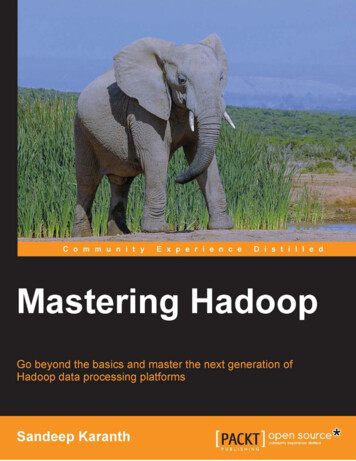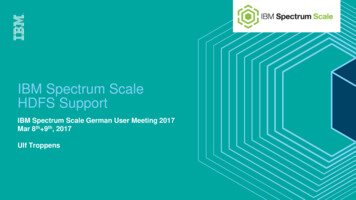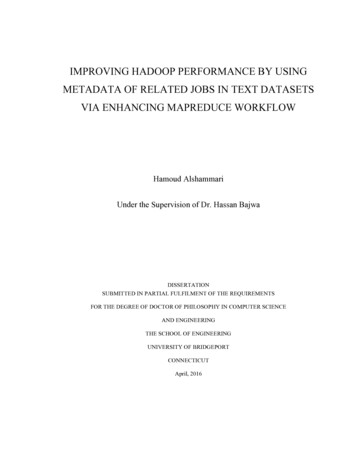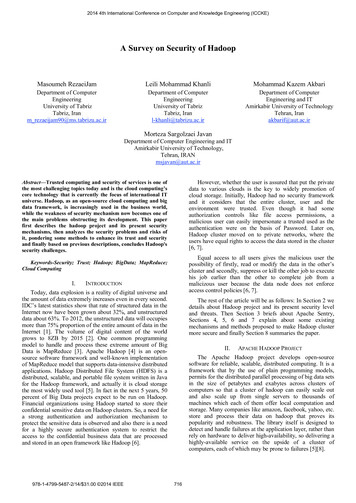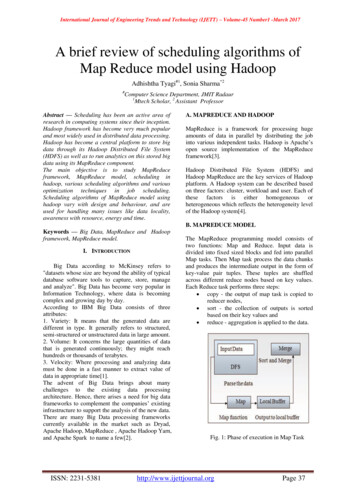
Transcription
HADOOP - QUICK GUIDEhttp://www.tutorialspoint.com/hadoop/hadoop quick guide.htmCopyright tutorialspoint.comHADOOP - BIG DATA OVERVIEW“90% of the world’s data was generated in the last few years.”Due to the advent of new technologies, devices, and communication means like social networkingsites, the amount of data produced by mankind is growing rapidly every year. The amount of dataproduced by us from the beginning of time till 2003 was 5 billion gigabytes. If you pile up the datain the form of disks it may fill an entire football field. The same amount was created in every twodays in 2011, and in every ten minutes in 2013. This rate is still growing enormously. Though allthis information produced is meaningful and can be useful when processed, it is being neglected.What is Big Data?Big Data is a collection of large datasets that cannot be processed using traditional computingtechniques. It is not a single technique or a tool, rather it involves many areas of business andtechnology.What Comes Under Big Data?Big data involves the data produced by different devices and applications. Given below are someof the fields that come under the umbrella of Big Data.Black Box Data : It is a component of helicopter, airplanes, and jets, etc. It captures voicesof the flight crew, recordings of microphones and earphones, and the performanceinformation of the aircraft.Social Media Data : Social media such as Facebook and Twitter hold information and theviews posted by millions of people across the globe.Stock Exchange Data : The stock exchange data holds information about the ‘buy’ and‘sell’ decisions made on a share of different companies made by the customers.Power Grid Data : The power grid data holds information consumed by a particular nodewith respect to a base station.Transport Data : Transport data includes model, capacity, distance and availability of avehicle.Search Engine Data : Search engines retrieve lots of data from different databases.
Thus Big Data includes huge volume, high velocity, and extensible variety of data. The data in itwill be of three types.Structured data : Relational data.Semi Structured data : XML data.Unstructured data : Word, PDF, Text, Media Logs.Benefits of Big DataUsing the information kept in the social network like Facebook, the marketing agencies arelearning about the response for their campaigns, promotions, and other advertisingmediums.Using the information in the social media like preferences and product perception of theirconsumers, product companies and retail organizations are planning their production.Using the data regarding the previous medical history of patients, hospitals are providingbetter and quick service.Big Data TechnologiesBig data technologies are important in providing more accurate analysis, which may lead to moreconcrete decision-making resulting in greater operational efficiencies, cost reductions, andreduced risks for the business.To harness the power of big data, you would require an infrastructure that can manage andprocess huge volumes of structured and unstructured data in realtime and can protect dataprivacy and security.There are various technologies in the market from different vendors including Amazon, IBM,Microsoft, etc., to handle big data. While looking into the technologies that handle big data, weexamine the following two classes of technology:Operational Big DataThese include systems like MongoDB that provide operational capabilities for real-time, interactiveworkloads where data is primarily captured and stored.NoSQL Big Data systems are designed to take advantage of new cloud computing architecturesthat have emerged over the past decade to allow massive computations to be run inexpensivelyand efficiently. This makes operational big data workloads much easier to manage, cheaper, andfaster to implement.Some NoSQL systems can provide insights into patterns and trends based on real-time data withminimal coding and without the need for data scientists and additional infrastructure.Analytical Big DataThese includes systems like Massively Parallel Processing MPP database systems and MapReducethat provide analytical capabilities for retrospective and complex analysis that may touch most orall of the data.MapReduce provides a new method of analyzing data that is complementary to the capabilitiesprovided by SQL, and a system based on MapReduce that can be scaled up from single servers tothousands of high and low end machines.These two classes of technology are complementary and frequently deployed together.Operational vs. Analytical SystemsOperationalAnalytical
Latency1 ms - 100 ms1 min - 100 minConcurrency1000 - 100,0001 - 10Access PatternWrites and ReadsReadsQueriesSelectiveUnselectiveData ScopeOperationalRetrospectiveEnd UserCustomerData ScientistTechnologyNoSQLMapReduce, MPP DatabaseBig Data ChallengesThe major challenges associated with big data are as follows:Capturing sPresentationTo fulfill the above challenges, organizations normally take the help of enterprise servers.HADOOP - BIG DATA SOLUTIONSTraditional Enterprise ApproachIn this approach, an enterprise will have a computer to store and process big data. For storagepurpose, the programmers will take the help of their choice of database vendors such as Oracle,IBM, etc. In this approach, the user interacts with the application, which in turn handles the part ofdata storage and analysis.LimitationThis approach works fine with those applications that process less voluminous data that can beaccommodated by standard database servers, or up to the limit of the processor that is processingthe data. But when it comes to dealing with huge amounts of scalable data, it is a hectic task toprocess such data through a single database bottleneck.Google’s SolutionGoogle solved this problem using an algorithm called MapReduce. This algorithm divides the taskinto small parts and assigns them to many computers, and collects the results from them whichwhen integrated, form the result dataset.HadoopUsing the solution provided by Google, Doug Cutting and his team developed an Open SourceProject called HADOOP.
Hadoop runs applications using the MapReduce algorithm, where the data is processed in parallelwith others. In short, Hadoop is used to develop applications that could perform completestatistical analysis on huge amounts of data.HADOOP - INTRODUCTION TO HADOOPHadoop is an Apache open source framework written in java that allows distributed processing oflarge datasets across clusters of computers using simple programming models. The Hadoopframework application works in an environment that provides distributed storage and computationacross clusters of computers. Hadoop is designed to scale up from single server to thousands ofmachines, each offering local computation and storage.Hadoop ArchitectureAt its core, Hadoop has two major layers namely:Processing/Computation layer MapReduce, andStorage layer HadoopDistributedFileSystem.MapReduceMapReduce is a parallel programming model for writing distributed applications devised at Googlefor efficient processing of large amounts of data multiterabytedata sets, on large clustersthousandsofnodes of commodity hardware in a reliable, fault-tolerant manner. The MapReduceprogram runs on Hadoop which is an Apache open-source framework.Hadoop Distributed File SystemThe Hadoop Distributed File System HDFS is based on the Google File System GFS and provides adistributed file system that is designed to run on commodity hardware. It has many similarities withexisting distributed file systems. However, the differences from other distributed file systems aresignificant. It is highly fault-tolerant and is designed to be deployed on low-cost hardware. Itprovides high throughput access to application data and is suitable for applications having largedatasets.Apart from the above-mentioned two core components, Hadoop framework also includes thefollowing two modules:Hadoop Common : These are Java libraries and utilities required by other Hadoop modules.Hadoop YARN : This is a framework for job scheduling and cluster resource management.How Does Hadoop Work?It is quite expensive to build bigger servers with heavy configurations that handle large scaleprocessing, but as an alternative, you can tie together many commodity computers with singleCPU, as a single functional distributed system and practically, the clustered machines can read thedataset in parallel and provide a much higher throughput. Moreover, it is cheaper than one highend server. So this is the first motivational factor behind using Hadoop that it runs across clusteredand low-cost machines.Hadoop runs code across a cluster of computers. This process includes the following core tasksthat Hadoop performs:Data is initially divided into directories and files. Files are divided into uniform sized blocks of128M and 64M preferably128M.These files are then distributed across various cluster nodes for further processing.HDFS, being on top of the local file system, supervises the processing.Blocks are replicated for handling hardware failure.
Checking that the code was executed successfully.Performing the sort that takes place between the map and reduce stages.Sending the sorted data to a certain computer.Writing the debugging logs for each job.Advantages of HadoopHadoop framework allows the user to quickly write and test distributed systems. It is efficient,and it automatic distributes the data and work across the machines and in turn, utilizes theunderlying parallelism of the CPU cores.Hadoop does not rely on hardware to provide fault-tolerance and high availability FTHA,rather Hadoop library itself has been designed to detect and handle failures at theapplication layer.Servers can be added or removed from the cluster dynamically and Hadoop continues tooperate without interruption.Another big advantage of Hadoop is that apart from being open source, it is compatible onall the platforms since it is Java based.HADOOP - ENVIORNMENT SETUPHadoop is supported by GNU/Linux platform and its flavors. Therefore, we have to install a Linuxoperating system for setting up Hadoop environment. In case you have an OS other than Linux,you can install a Virtualbox software in it and have Linux inside the Virtualbox.Pre-installation SetupBefore installing Hadoop into the Linux environment, we need to set up Linux using ssh SecureShell.Follow the steps given below for setting up the Linux environment.Creating a UserAt the beginning, it is recommended to create a separate user for Hadoop to isolate Hadoop filesystem from Unix file system. Follow the steps given below to create a user:Open the root using the command “su”.Create a user from the root account using the command “useradd username”.Now you can open an existing user account using the command “su username”.Open the Linux terminal and type the following commands to create a user. supassword:# useradd hadoop# passwd hadoopNew passwd:Retype new passwdSSH Setup and Key GenerationSSH setup is required to do different operations on a cluster such as starting, stopping, distributeddaemon shell operations. To authenticate different users of Hadoop, it is required to providepublic/private key pair for a Hadoop user and share it with different users.The following commands are used for generating a key value pair using SSH. Copy the public keysform id rsa.pub to authorized keys, and provide the owner with read and write permissions toauthorized keys file respectively. ssh-keygen -t rsa
cat /.ssh/id rsa.pub /.ssh/authorized keys chmod 0600 /.ssh/authorized keysInstalling JavaJava is the main prerequisite for Hadoop. First of all, you should verify the existence of java in yoursystem using the command “java -version”. The syntax of java version command is given below. java -versionIf everything is in order, it will give you the following output.java version "1.7.0 71"Java(TM) SE Runtime Environment (build 1.7.0 71-b13)Java HotSpot(TM) Client VM (build 25.0-b02, mixed mode)If java is not installed in your system, then follow the steps given below for installing java.Step 1Download java JDK latestversion X64.tar. gz by visiting the following downloads/jdk7-downloads1880260.html.Then jdk-7u71-linux-x64.tar.gz will be downloaded into your system.Step 2Generally you will find the downloaded java file in Downloads folder. Verify it and extract the jdk7u71-linux-x64.gz file using the following commands. cd Downloads/ lsjdk-7u71-linux-x64.gz tar zxf jdk-7u71-linux-x64.gz lsjdk1.7.0 71jdk-7u71-linux-x64.gzStep 3To make java available to all the users, you have to move it to the location “/usr/local/”. Open root,and type the following commands. supassword:# mv jdk1.7.0 71 /usr/local/# exitStep 4For setting up PATH and JAVA HOME variables, add the following commands to /.bashrc file.export JAVA HOME /usr/local/jdk1.7.0 71export PATH PATH: JAVA HOME/binNow verify the java -version command from the terminal as explained above.Downloading HadoopDownload and extract Hadoop 2.4.1 from Apache software foundation using the followingcommands. su
password:# cd /usr/local# wget hadoop-2.4.1.tar.gz# tar xzf hadoop-2.4.1.tar.gz# mv hadoop-2.4.1/* to hadoop/# exitHadoop Operation ModesOnce you have downloaded Hadoop, you can operate your Hadoop cluster in one of the threesupported modes:Local/Standalone Mode : After downloading Hadoop in your system, by default, it isconfigured in a standalone mode and can be run as a single java process.Pseudo Distributed Mode : It is a distributed simulation on single machine. Each Hadoopdaemon such as hdfs, yarn, MapReduce etc., will run as a separate java process. This mode isuseful for development.Fully Distributed Mode : This mode is fully distributed with minimum two or moremachines as a cluster. We will come across this mode in detail in the coming chapters.Installing Hadoop in Standalone ModeHere we will discuss the installation of Hadoop 2.4.1 in standalone mode.There are no daemons running and everything runs in a single JVM. Standalone mode is suitablefor running MapReduce programs during development, since it is easy to test and debug them.Setting Up HadoopYou can set Hadoop environment variables by appending the following commands to /.bashrcfile.export HADOOP HOME /usr/local/hadoopBefore proceeding further, you need to make sure that Hadoop is working fine. Just issue thefollowing command: hadoop versionIf everything is fine with your setup, then you should see the following result:Hadoop 2.4.1Subversion https://svn.apache.org/repos/asf/hadoop/common -r 1529768Compiled by hortonmu on 2013-10-07T06:28ZCompiled with protoc 2.5.0From source with checksum 79e53ce7994d1628b240f09af91e1af4It means your Hadoop's standalone mode setup is working fine. By default, Hadoop is configuredto run in a non-distributed mode on a single machine.ExampleLet's check a simple example of Hadoop. Hadoop installation delivers the following exampleMapReduce jar file, which provides basic functionality of MapReduce and can be used forcalculating, like Pi value, word counts in a given list of files, etc. HADOOP les-2.2.0.jarLet's have an input directory where we will push a few files and our requirement is to count thetotal number of words in those files. To calculate the total number of words, we do not need towrite our MapReduce, provided the .jar file contains the implementation for word count. You can
try other examples using the same .jar file; just issue the following commands to check supportedMapReduce functional programs by hadoop-mapreduce-examples-2.2.0.jar file. hadoop jar HADOOP es-2.2.0.jarStep 1Create temporary content files in the input directory. You can create this input directory anywhereyou would like to work. mkdir input cp HADOOP HOME/*.txt input ls -l inputIt will give the following files in your input directory:total 24-rw-r--r-- 1 root root 15164 Feb 21 10:14 LICENSE.txt-rw-r--r-- 1 root root101 Feb 21 10:14 NOTICE.txt-rw-r--r-- 1 root root 1366 Feb 21 10:14 README.txtThese files have been copied from the Hadoop installation home directory. For your experiment,you can have different and large sets of files.Step 2Let's start the Hadoop process to count the total number of words in all the files available in theinput directory, as follows: hadoop jar HADOOP es-2.2.0.jarwordcount input ouputStep 3Step-2 will do the required processing and save the output in output/part-r00000 file, which youcan check by using: cat output/*It will list down all the words along with their total counts available in all the files available in theinput directory."AS4"Contribution" 1"Contributor" 1"Derivative 1"Legal ontrol"1"printed1"submitted"1(50%)1(BIS),1
ing Hadoop in Pseudo Distributed ModeFollow the steps given below to install Hadoop 2.4.1 in pseudo distributed mode.Step 1: Setting Up HadoopYou can set Hadoop environment variables by appending the following commands to xportexportHADOOP HOME /usr/local/hadoopHADOOP MAPRED HOME HADOOP HOMEHADOOP COMMON HOME HADOOP HOMEHADOOP HDFS HOME HADOOP HOMEYARN HOME HADOOP HOMEHADOOP COMMON LIB NATIVE DIR HADOOP HOME/lib/nativePATH PATH: HADOOP HOME/sbin: HADOOP HOME/binHADOOP INSTALL HADOOP HOMENow apply all the changes into the current running system. source /.bashrcStep 2: Hadoop ConfigurationYou can find all the Hadoop configuration files in the location “ HADOOP HOME/etc/hadoop”. It isrequired to make changes in those configuration files according to your Hadoop infrastructure. cd HADOOP HOME/etc/hadoopIn order to develop Hadoop programs in java, you have to reset the java environment variables inhadoop-env.sh file by replacing JAVA HOME value with the location of java in your system.export JAVA HOME /usr/local/jdk1.7.0 71The following are the list of files that you have to edit to configure Hadoop.core-site.xmlThe core-site.xml file contains information such as the port number used for Hadoop instance,memory allocated for the file system, memory limit for storing the data, and size of Read/Writebuffers.Open the core-site.xml and add the following properties in between configuration , /configuration tags. configuration property name fs.default.name /name value hdfs://localhost:9000 /value /property /configuration hdfs-site.xmlThe hdfs-site.xml file contains information such as the value of replication data, namenode path,
and datanode paths of your local file systems. It means the place where you want to store theHadoop infrastructure.Let us assume the following data.dfs.replication (data replication value) 1(In the below given path /hadoop/ is the user name.hadoopinfra/hdfs/namenode is the directory created by hdfs file system.)namenode path a/hdfs/datanode is the directory created by hdfs file system.)datanode path //home/hadoop/hadoopinfra/hdfs/datanodeOpen this file and add the following properties in between the configuration /configuration tags in this file. configuration property name dfs.replication /name value 1 /value /property property name dfs.name.dir /name value file:///home/hadoop/hadoopinfra/hdfs/namenode /value /property property name dfs.data.dir /name value file:///home/hadoop/hadoopinfra/hdfs/datanode /value /property /configuration Note: In the above file, all the property values are user-defined and you can make changesaccording to your Hadoop infrastructure.yarn-site.xmlThis file is used to configure yarn into Hadoop. Open the yarn-site.xml file and add the followingproperties in between the configuration , /configuration tags in this file. configuration property name yarn.nodemanager.aux-services /name value mapreduce shuffle /value /property /configuration mapred-site.xmlThis file is used to specify which MapReduce framework we are using. By default, Hadoop containsa template of yarn-site.xml. First of all, it is required to copy the file from mapredsite,xml.template to mapred-site.xml file using the following command. cp mapred-site.xml.template mapred-site.xmlOpen mapred-site.xml file and add the following properties in between the configuration , /configuration tags in this file. configuration property name mapreduce.framework.name /name
value yarn /value /property /configuration Verifying Hadoop InstallationThe following steps are used to verify the Hadoop installation.Step 1: Name Node SetupSet up the namenode using the command “hdfs namenode -format” as follows. cd hdfs namenode -formatThe expected result is as follows.10/24/14 21:30:55 INFO namenode.NameNode: STARTUP ***************STARTUP MSG: Starting NameNodeSTARTUP MSG:host localhost/192.168.1.11STARTUP MSG:args [-format]STARTUP MSG:version 2.4.1.10/24/14 21:30:56 INFO common.Storage: Storage directory/home/hadoop/hadoopinfra/hdfs/namenode has been successfully formatted.10/24/14 21:30:56 INFO namenode.NNStorageRetentionManager: Going toretain 1 images with txid 010/24/14 21:30:56 INFO util.ExitUtil: Exiting with status 010/24/14 21:30:56 INFO namenode.NameNode: SHUTDOWN ***************SHUTDOWN MSG: Shutting down NameNode at ********************************/Step 2: Verifying Hadoop dfsThe following command is used to start dfs. Executing this command will start your Hadoop filesystem. start-dfs.shThe expected output is as follows:10/24/14 21:37:56Starting namenodes on [localhost]localhost: starting namenode, logging to de-localhost.outlocalhost: starting datanode, logging to de-localhost.outStarting secondary namenodes [0.0.0.0]Step 3: Verifying Yarn ScriptThe following command is used to start the yarn script. Executing this command will start youryarn daemons. start-yarn.shThe expected output as follows:starting yarn daemons
starting resourcemanager, logging to manager-localhost.outlocalhost: starting nodemanager, logging to ger-localhost.outStep 4: Accessing Hadoop on BrowserThe default port number to access Hadoop is 50070. Use the following url to get Hadoop serviceson browser.http://localhost:50070/Step 5: Verify All Applications for ClusterThe default port number to access all applications of cluster is 8088. Use the following url to visitthis service.http://localhost:8088/HADOOP - HDFS OVERVIEWHadoop File System was developed using distributed file system design. It is run on commodityhardware. Unlike other distributed systems, HDFS is highly faulttolerant and designed using lowcost hardware.HDFS holds very large amount of data and provides easier access. To store such huge data, thefiles are stored across multiple machines. These files are stored in redundant fashion to rescue thesystem from possible data losses in case of failure. HDFS also makes applications available toparallel processing.Features of HDFSIt is suitable for the distributed storage and processing.Hadoop provides a command interface to interact with HDFS.The built-in servers of namenode and datanode help users to easily check the status ofcluster.Streaming access to file system data.HDFS provides file permissions and authentication.HDFS ArchitectureGiven below is the architecture of a Hadoop File System.HDFS follows the master-slave architecture and it has the following elements.NamenodeThe namenode is the commodity hardware that contains the GNU/Linux operating system and thenamenode software. It is a software that can be run on commodity hardware. The system havingthe namenode acts as the master server and it does the following tasks:Manages the file system namespace.Regulates client’s access to files.It also executes file system operations such as renaming, closing, and opening files anddirectories.
DatanodeThe datanode is a commodity hardware having the GNU/Linux operating system and datanodesoftware. For every node Commodityhardware/System in a cluster, there will be a datanode. These nodesmanage the data storage of their system.Datanodes perform read-write operations on the file systems, as per client request.They also perform operations such as block creation, deletion, and replication according tothe instructions of the namenode.BlockGenerally the user data is stored in the files of HDFS. The file in a file system will be divided intoone or more segments and/or stored in individual data nodes. These file segments are called asblocks. In other words, the minimum amount of data that HDFS can read or write is called a Block.The default block size is 64MB, but it can be increased as per the need to change in HDFSconfiguration.Goals of HDFSFault detection and recovery : Since HDFS includes a large number of commodityhardware, failure of components is frequent. Therefore HDFS should have mechanisms forquick and automatic fault detection and recovery.Huge datasets : HDFS should have hundreds of nodes per cluster to manage theapplications having huge datasets.Hardware at data : A requested task can be done efficiently, when the computation takesplace near the data. Especially where huge datasets are involved, it reduces the networktraffic and increases the throughput.HADOOP - HDFS OPERATIONSStarting HDFSInitially you have to format the configured HDFS file system, open namenode HDFSserver, andexecute the following command. hadoop namenode -formatAfter formatting the HDFS, start the distributed file system. The following command will start thenamenode as well as the data nodes as cluster. start-dfs.shListing Files in HDFSAfter loading the information in the server, we can find the list of files in a directory, status of a file,using ‘ls’. Given below is the syntax of ls that you can pass to a directory or a filename as anargument. HADOOP HOME/bin/hadoop fs -ls args Inserting Data into HDFSAssume we have data in the file called file.txt in the local system which is ought to be saved in thehdfs file system. Follow the steps given below to insert the required file in the Hadoop file system.Step 1You have to create an input directory.
HADOOP HOME/bin/hadoop fs -mkdir /user/inputStep 2Transfer and store a data file from local systems to the Hadoop file system using the putcommand. HADOOP HOME/bin/hadoop fs -put /home/file.txt /user/inputStep 3You can verify the file using ls command. HADOOP HOME/bin/hadoop fs -ls /user/inputRetrieving Data from HDFSAssume we have a file in HDFS called outfile. Given below is a simple demonstration for retrievingthe required file from the Hadoop file system.Step 1Initially, view the data from HDFS using cat command. HADOOP HOME/bin/hadoop fs -cat /user/output/outfileStep 2Get the file from HDFS to the local file system using get command. HADOOP HOME/bin/hadoop fs -get /user/output/ /home/hadoop tp/Shutting Down the HDFSYou can shut down the HDFS by using the following command. stop-dfs.shHADOOP - COMMAND REFERENCEHDFS Command ReferenceThere are many more commands in " HADOOP HOME/bin/hadoop fs" than are demonstratedhere, although these basic operations will get you started. Running ./bin/hadoop dfs with noadditional arguments will list all the commands that can be run with the FsShell system.Furthermore, HADOOP HOME/bin/hadoop fs -help commandName will display a short usagesummary for the operation in question, if you are stuck.A table of all the operations is shown below. The following conventions are used for parameters:" path " means any file or directory name." path ." means one or more file or directory names." file " means any filename." src " and " dest " are path names in a directed operation." localSrc " and " localDest " are paths as above, but on the local file system.All other files and path names refer to the objects inside HDFS.
CommandDescription-ls path Lists the contents of the directory specified by path, showing the names,permissions, owner, size and modification date for each entry.-lsr path Behaves like -ls, but recursively displays entries in all subdirectories of path.-du path Shows disk usage, in bytes, for all the files which match path; filenames arereported with the full HDFS protocol prefix.-dus path Like -du, but prints a summary of disk usage of all files/directories in thepath.-mv src dest Moves the file or directory indicated by srcto dest, within HDFS.-cp src dest Copies the file or directory identified by src to dest, within HDFS.-rm path Removes the file or empty directory identified by path.-rmr path Removes the file or directory identified by path. Recursively deletes anychild entries i. e. , filesorsubdirectoriesofpath.-put localSrc dest Copies the file or directory from the local file system identified by localSrc todest within the DFS.-copyFromLocal localSrc dest Identical to -put-moveFromLocal localSrc dest Copies the file or directory from the local file system identified by localSrc todest within HDFS, and then deletes the local copy on success.-get [-crc] src localDest Copies the file or directory in HDFS identified by src to the local file systempath identified by localDest.-getmerge src localDest Retrieves all files that match the path src in HDFS, and copies them to asingle, merged file in the local file system identified by l
Hadoop framework allows the user to quickly write and test distributed systems. It is efficient, and it automatic distributes the data and work across the machines and in turn, utilizes the underlying parallelism of the CPU cores. Hadoop does not rely on hardware to provide fault-tolerance and high availability FTHA,
